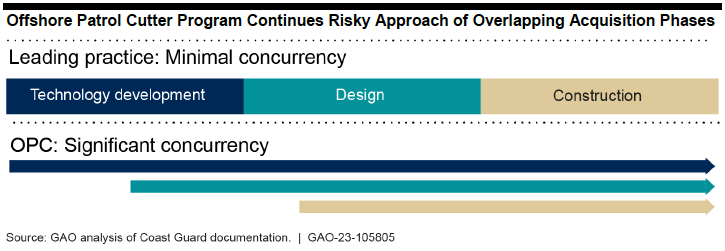The following is the June 20, 2023, Government Accountability Office, U.S. Coast Guard Acquisitions: Offshore Patrol Cutter Program Needs to Mature Technology and Design.
From the report
What GAO Found
In October 2020, GAO found that the Offshore Patrol Cutter (OPC) program started construction on the lead ship with an unstable design. In this report, GAO found that the Coast Guard continues its approach of progressing through the technology development, design, and construction phases concurrently, which increases risk and is contrary to leading practices.

The Coast Guard has not developed a plan to mature the stage 1 OPC’s critical technology—the davit (a crane that deploys and retrieves a cutter’s small boats). Nor has the program integrated and demonstrated the davit in a realistic environment. Without a plan to mature the davit and demonstrate it before delivery, the Coast Guard risks further delays and costly rework.
In addition, the Coast Guard has not aligned its shipbuilding acquisition policy with shipbuilding leading practices. Specifically, the Coast Guard does not require completion of basic and functional design and maturity of all critical technologies, as GAO previously recommended. It also does not require completion of the design of distributive systems—systems that affect multiple zones of the ship—prior to construction of the lead ship. Significant rework can occur late in construction, resulting in subsequent cost growth and delays, if design of distributive systems are not completed prior to construction.
The OPC’s total acquisition cost estimate increased from $12.5 billion to $17.6 billion between 2012 and 2022. The program attributes the 40 percent increase to many factors, including restructuring the stage 1 contract and recompeting the stage 2 requirement in response to a disruption caused by Hurricane Michael, and increased infrastructure costs for homeports and facilities, among other things. In addition, the program incurred a 1.5-year delay in the delivery of the first four OPCs due to Hurricane Michael and issues related to manufacturing the cutter’s propulsion system. GAO also found indicators that the shipbuilder’s significant level of complex, uncompleted work may lead to further delays.
Further, the Coast Guard faces an operational gap between the OPCs and the Medium Endurance Cutters (MEC), which the OPCs are replacing. This gap could worsen should the OPC program fall further behind schedule. All 28 MECs have exceeded their design service lives. The Coast Guard started a $1.86 billion acquisition program to extend the service life of six MECs, but the fleet faces risks of failure due to age and obsolescence.
Why GAO Did This Study
The Coast Guard plans to acquire a fleet of 25 OPCs—four ships in stage 1, 11 ships in stage 2, and 10 ships in a later effort—from at least two different shipbuilders. This is the component’s highest investment priority. The OPCs will help ensure a variety of missions in offshore waters once the current fleet of aging MECs is decommissioned.
GAO was asked to review the OPC acquisition program’s status and the Coast Guard’s plans for the MECs. This report examines the extent to which (1) the OPC’s design and construction practices are consistent with shipbuilding leading practices, (2) the OPC is meeting cost and schedule goals, and (3) a gap exists between the decommissioning of the MEC fleet
and the deployment of the OPCs. GAO analyzed Coast Guard program documents and data, and interviewed Coast Guard officials and shipbuilder representatives.
What GAO Recommends
GAO continues to believe that its October 2020 recommendations have merit. GAO is making five new recommendations to the Coast Guard, including that it develop a technology maturation plan for the davit; demonstrate the davit in a realistic environment; and update its acquisition policy to require programs to complete routing of distributive systems as part of functional design prior to lead ship construction. DHS concurred with three of five recommendations, and did not concur with two. GAO has raised to the attention of Congress two matters for its consideration, as discussed in the report.
Download the document here.





